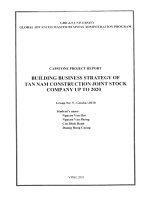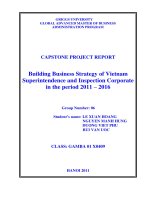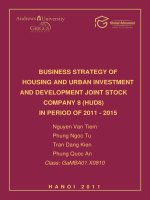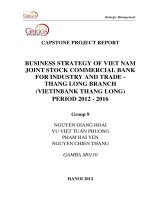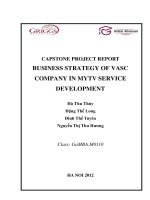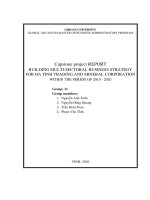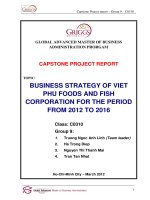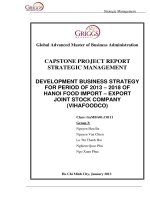Business strategy of Hanoi housing development and investment company No.5 - Handico 5 - period 2011-2015
Bạn đang xem bản rút gọn của tài liệu. Xem và tải ngay bản đầy đủ của tài liệu tại đây (2.72 MB, 90 trang )
- 0 -
1
TABLE OF CONTENTS
Page
TABLE OF CONTENTS…………………………………………………. 1
LIST OF FIGURES/TABLES……………………………………………. 4
FOREWORDS…………………………………………………………… 5
CHAPTER I : THEORY FOUNDATION
CORE OF STARTEGY AND STRATEGY PLANNING PROCESS…. 6
1.1
Core of strategy
7
1.1.1.
Strategy viewpoints
7
1.1.2.
Definition of types of strategies ……………………………
8
1.1.3.
Features of business strategy …………………………………
9
1.1.4.
Strategy establishment process ……………………………….
10
1.2.
Strategy planning ……… …………………………
11
1.2.1.
Analyzing external environments …… ………………………
13
1.2.2.
Analyzing internal environment of enterprises ……………….
19
1.2.3.
General model of internal and external analysis (SWOT)…….
21
CHAPTER II : ANALYZING THE SITUATION OF HANDICO5… 29
2.1.
Introduction on HANDICO5……………………………
29
2.1.1.
General information …………………………………………
29
2.1.2.
Organizational structure and management structure
31
2.1.3.
Business results period 2008 – 2010
32
2.1.4.
General commnets on the business situation
33
2
2.1.5.
Business situation via projects in progress
35
2.2.
Analyzing the external environments ………………………
36
2.2.1
Analyzing macro - environment (PEST)…………………
36
2.2.2.
Analyzing branch environment (Five forces)………………
43
2.2.3.
Building matrix of external factor evaluation (EFE Matrix)….
51
2.3.
Analyzing internal environment under value chain model
53
2.3.1.
Supporting activities …………………………………………
53
2.3.2.
Main activities ………………………………………………
56
2.3.3.
2.4.
Setting up matrix of internal factor evaluation (IFE Matrix)
I – E Matrix…………………………………………………
58
60
CHAPTER III: BUSINESS STRATEGY PLANNING FOR
HANDICO5 (PERIOD 2011 – 2015)………………… 61
3.1.
Definition of missions, visions and operation principles……
61
3.1.1.
Missions………………………………………………………….
61
3.1.2.
Vision……………………………………………………
61
3.1.3.
3.1.4.
Operation prinples
Influence of Handico Strategy on Handico5……………………
61
61
3.2.
Targets up to 2015…………………………………………
62
3.3.
SWOT Matrix – Selected business strategies…………………
62
3.4.
Selection of the optimal business strategies
64
3.5.
Some solutions for the performance of the selected business
strategy……………………………………………………….…
66
3.5.1.
Definition of the target markets………………………………….
66
3.5.2.
Solutions on technology ……………………………………
67
3.5.3.
Solutions on finance and sales …………………………………
69
3.5.4.
Developing brand name ……………………………………
70
3.5.5.
Solutions on human resources …………………………………
71
3
3.5.6.
Groups of solutions for internal organization during the strategy
performance ……………………………………………………
72
3.6.
Limitation of the research and the orientation of the research
in the future
73
3.6.1.
About the geographical position for reseach
73
3.6.2.
About references
73
3.6.3.
Analyzing time
74
3.6.4.
Targets
74
3.6.5.
The following reseach trennds
74
CONCLUSION AND RECOMMENDATIONS ……………………….
75
REFERENCES …………
76
APPENDICES ………………………………………………………
78
4
LIST OF FIGURES
No
Code
Figure Name
Page
1
1.1
Emergent Strategies and deliberate strategies
7
1.2
Components of strategy establishment process
10
1.3
Foundations of company mission formation
11
1.4
Strategy establishment process
13
1.5
Model of Michael Porter of 5 competition forces
16
1.6
Diagram of Value chain
21
2
2.1
Organizational structure of HANDICO5
31
3
3.1
Simulation of savings level of shaped concrete technology
68
3.2
Orientation of organizational structure of HANDICO5 period
2011-2015
73
LIST OF TABLES
No
Code
Tables Name
Page
1
1.1
Matrix of external factors of enterprises (EFE)
15
1.2
Internal factor evaluation matrix (IFE)
23
1.3
Diagram of SWOT matrix
24
1.4
Quantitative matrix with GREAT criteria
25
1.5
Sources of competition advantages and basic competition
strategies
27
2
2.1
Share ownership structure of HANDICO5
32
2.2
Some criteria of business operations of HANDICO5 2008 -
2010
32
2.3
Some financial index of HANDICO5 period 2008 - 2010
33
2.4
Some projects in progress by HANDICO5 2008 - 2010
35
2.5
Comparison table of some business criteria of HANDICO5 with
its existing competitors
45
2.6a
Customer objects of HANDICO5
Classification of Customer objects
47
2.6b
Customer objects of HANDICO5
Customers’ features of HANDICO5
48
2.7
Demand on input supply of HANDICO5
49
2.8
Matrix of external factor evaluation on HANDICO5 (EFE)
52
2.9
Analyzing infrastructure of HANDICO5
54
2.10
Analyzing human resources of HANDICO5
55
2.11
Table of analysis and comparison of HANDICO5 with
competitors
57
2.12
Matrix of internal factor evaluation of HANDICO5 (IFE)
59
3
3.1
Business criteria of HANDICO5 period 2011-2015
62
3.2
SWOT matrix for HANDICO5
63
3.3
Quantitative matrix under GREAT criteria
65
5
Forewords
Strategy planning is a process to define the huge direction for an enterprise on its
changes, improvement, development and setting up its competitive advantages.
Application of strategy is mostly the “individual story” of large enterprises. There
are a lot of researches show that strategy planning has a close relation with the
financial efficiency of small and middle sized enterprises (SMEs) but up to now,
many small and middle sized enterprises has ignored their attention in this issue.
Over nearly 20 years performance of economic innovation policies, SMEs have
archived wonderful successes, step by step stated their roles in the economy.
However, every year, there are hundreds of SMEs coming the bankrupts or
“disappearance” in the market. There are a lot of reasons for this, but one of them is
lack of strategic thinking, which starts by the shortage capacity of business strategy
planning and ends by a failure in the development of a control system to remain
their business success.
This research is targeted to give a new plan in the business policy of an enterprise
working in real estate in Hanoi. The selected enterprise is Hanoi Housing
Development and Investment Company No. 5 – HANDICO5, an enterprise in Joint
Stock Company (a popular form of enterprises now), which is a SME and started by
a State owned one. The research tries to analyze the general situation of the
economy, development trend and changes in the market, strengths and weakness of
HANDICO5 and the relation with other enterprises, applying suitable theories of
administration, especially strategic administration to give the directions and
orientations for the business strategy of HANDICO5 period 2011-2015, to meet the
continuous development of the competitive and affective factors. By this way, the
performance of the optimization of benefits of shareholders as well as of customers
shall be made. By the practical situation of the enterprise and limitation in time, the
research only takes into the planning process of the business strategy from 2011 to
2015 of HANDICO5 in which it concentrates to define the targets and the most
6
suitable market segment should be followed by HANDICO. Therefore, the
enterprise image shall be built as well as business development shall be set up
clearly.
The shortages in this research can not be ignored and they are not expected. We
hope that we will receive more instructions of Professions, teachers and researchers
and colleagues for the completion of the research and for the development of
HANDICO5 in the future, and further it shall be for the construction and
development of the real estate, and improvement of our knowledge, the members in
this research.
Hanoi, September 2011
Group 7, GaMBA01.N06
7
CHAPTER I
THEORY FOUNDATION
1.1. Core of strategies
1.1.1. Strategy viewpoints
According to Alfred Chandler [2], strategy: “is the establishment of basic long-term
targets of an enterprise, and the performance of action programs as well as the
distribution of necessary resources to meet such targets”. The most impressive ideology
expressed in the Chandler’s definition is the rational planning, the enterprise is
descibed under the form that it can select its owned purposes, define its action
programs (strategy) to complete these purposes, distribute respecitve resources.
Similarly, James B.Quinn [12] defined strategy as “the model or plan of an
organization to combine main targets, policies and action schedule in an uniform way”.
Even though there are many attractive points, planning – based definitions still get
some opposite feedback that this approach impliedly accepts an incorrect asumption
as strategy is the expected result of a plan. The definitions focus on aspects of a
plan. However, they leave out that strategy of a company can be raised from the
company not via any formal plans (refer to figure 1.1). That means, Company’s
strategy can be proposed by a staff, even it is not planned. In fact, Company’s
strategy can be given by unforecasted conditions. By this way, Company’s strategy
is a model in the flow of decisions and action programs. Models can be resulted by
any strategies – designed strategies or unplanned strategies which bring success and
become more suitable than the planned ones.
Figure 1.1 - Emergent Strategies and deliberate strategies
(Sources: H. Mintzberg, J. Lampel, J.B. Quin, S. Ghoshal, The strategy process,
Pearson Education Limited, 2003, P.5.)
Realized
strategies
Deliberate
strategies
Unrealized
strategies
Emgergent
strategies
Planned
strategies
8
To sum up, Strategy is a series of decisions for the development and changes in
internal essences of an enterprise. This view makes the real value of the strategy in
clarity: Strategy not only supports for the success of the enterprise in its competition
but also it pushes the enterprise in its development.
1.1.2. Definitions of kinds of strategies [4]
a) Corporate-level strategy
Corporate-level strategy defines the business line (or business lines) being taken or
shall be taken by the Company, how each line shall be taken (e.g. incorporation
with other branches of Company or taken in the independent business, or in capture
or new investment, which lines shall be remained, which lines shall be leaved out
and which new lines should be taken) and its relation with the society, or in other
words, Corporate-level strategy is the selection of business lines. Thereof, the
Company should give the development trend for single business units or multi
business units.
b) Business-level strategy or Business strategy
Business strategy: is the determination of an enterprise to compete in an identical
sector or a defined line. For sustainable development in any sectors, it is necessary
to set up its competitive advantages in comparison with other competitors,
therefore, business strategy shall be considered as the competitive strategy.
Competitive strategy of an enterprise is the way to set up its valuable position in this
sector. It covers a wide vision (including actual meaning and implied meaning) in
customers in its service and how to bring its value to customers. However, a
competitive strategy is not only a vision but also it is the combination of certain
actions and detailed processes in the operation of an enterprise, which creates
special values for customers. Therefore, strategy shall regulate operations of an
enterprise and efforts of the enterprise shall push the potential advantages.
Corporate –level strategy defines how the enterprise complete its functions (so, it
shall help for the completion of Company’s strategy) in its business sector.
9
Business –level strategy plays the same importance with single sector enterprises as
well as specific enterprises in multi-sector enterprises.
c) Function-level strategy.
Function –level strategy shall support for Company’s strategy and business strategy.
For single sector enterprises and each business of multi-sector enterprises, function
– level strategy is similar. Function-level strategy shall create the foundation for
others such as marketing strategy, financial strategy, R&D strategy, operation
strategy to improve the competitive strategy of the enterprise and define actions and
process to get advantages given by this competitive advantages
d) Global strategy
Nowadays, on the global market and global competitions, in order to get the
competitive advantages as well as optimize the operation results of a company, it is
necessary to enlarge its operations over the local boundary. It means that Company
should consider other global strategies which it can follow. Benefits and expenses to
widen the market over the local countries shall be evaluated and considered to select
the strategy.
1.1.3. Features of Business strategy [4]
Strategy viewpoints have not found the common points. However, in any aspects, in
any periods, strategy has remained its typical features which reflect the core of the
strategy of an enterprise. The main features of strategy as follows:
Business strategy should define the main targets should be caught in each
period and applied in all aspects, all levels of business and production activities
of an enterprise
Business strategy of an enterprise should be reflected in a continuous process
from the construction to implementation, testing and evaluation, adjustment and
performance of each planned target.
Business strategy should mobilize and develop the use of enterprise’s resources
(labor, capital, techniques, and technologies, etc), develop all advantages, catch
changes to get the competitive advantages in the market.
10
Strategy is a tool to set up long-term targets of enterprises. Business strategy
should define the competition range of an enterprise.
The key issue of this feature is the definition of business range of an enterprise.
It is an important step in business environment analysis, orientation of strategy,
resource allocation, and portfolio management. The two basic questions are
raised including: What is in our business? And what we should make business?
It is a complex issue during the market segment which affects the definition of
structural organization of an enterprise.
Business strategy creates a mutual relation between opportunities and threats
out of an enterprise, strengths and weakness of an enterprise and makes the
competitive advantages.
This feature generates a key issue of strategy is that it shall generate long-term and
sustainable competitive advantage in comparison with the main competitors of the
enterprise in its business range. It is a modern approach to research the competitive
advantages of enterprise.
1.1.4. Strategy establishment process
In order to set up a process of a business strategy, should image a general
establishment process for Company. According to the common model of strategy
management, the strategy establishment is the core step covering the components as
stated in the table 1.2 below.
Figure 1.2 – Components of strategy establishment process
(Source: Hill W. L. Ch. & Jones R. G. (1995), Strategic management, Houghton Mifflin Company, p.5).
Internal analysis
(Strengths and
weakness)
8
Strategy selection
External analysis
(Opportunities &
Threats)
Define strategy missions and
targets
Analyzing and
selecting SWOT
strategy
11
Definition of mission and targets of strategy
The first component of strategy establishment process is the definition of the
strategy visions and missions. The Strategy visions and mission of Company shall
make the conditions to form the planned strategy and give evaluation criteria of the
emergent strategy.
Missions state the reasons why the company remains and what Company should do.
For example, missions of a national airway are to satisfy the high tech
transportation demand with reasonable price for individuals and organizations of all
large population areas. In consideration of missions, the statement of missions given
by Company shall be formed by the following factors: (i) Business lines of
company; (ii) philosophy of Company; (iii) aspirations of the Company’s senior
leaders (refer to Figure 1.3).
Figure 1.3 – Foundations of company mission formation
(Source:: Hoang Van Hai (Chief author), (2010), Strategy management, P 19)
What are
business lines
of Company?
What are
aspirations of
Senior leaders
of Company ?
What is
business
philosophy of
Company?
12
Strategy targets state long-term and short-term aspirations of Company. Most of
profit organizations always set up systems of targets to optimize the benefits of
shareholders.
Setting up strategy targets is to make strategy missions and orientations in results, to
reach the expected achievements. Targets are considered as the commitments of
leaders for identified results in a certain period. They are expressed in types of
success, how many successes are and when successes are reached. They pay
attention and concentrate their capacity in the targets should be completed.
Selection of strategy
After the internal and external environment analysis is made, it is required to give
alternative strategies on the strengths and weakness of the Company as well as its
opportunities and threats of analyzed external environment. Comparisons between
strengths, weakness, opportunities and threats are called SWOT analysis. SWOT
analysis is purposed to set up the Company’s strengths to exploit possible
opportunities, response threats and adjust weakness. In order to select the best
strategy among ones given by SWOT analysis, it is required to evaluate each
strategy meeting the capacity of missions and targets. Alternative strategies should
cover levels and function one, business level one, and general one for the company
as well as global one. Selection of strategy requires the collection of strategies at
any levels for the best development in the global competitive environment with the
changes of almost modern industries.
Company strategy shall define the competitive way in a certain business line. It
shall be formed by 3 factors: Company strategy, analysis results of business lines
and internal analysis of Company. Therefore, strategy establishment process of
company shall be stated as in Figure 1.4.
13
1.2. Strategy planning
1.2.1. Analyzing external environments
External environment is factors which can affect the target performance of an
enterprise. Analyzing the external environment covers the analysis of macro-
environment and micro-environment. By analyzing these factors, enterprise can
define its position and features of the environment, conditions as well as give
effects of the external environment on the enterprise and the enterprise targets for
decisions and directions.
a) Analyzing macro-environment (PEST) [8]
Figure 1.4 – Strategy establishment process
Company strategy
Set up and select
strategies
SWOT Model
Analyzing sector
Applied model:
Five Forces
Competition pressure
Opportunities and
threats
Internal analysis
Applied model :
Value Chain
Strengths and
weakness
Leading in
expenditures
Distinction
Focus and center
points
- Different in nature
- Different in images
- Different in services
- Price
- Difference
(Sources: T.L Wheelen, J.D Hunger, Essentials of Strategic Management, Prentice Hall Publishing
Company, 2001, p.12 and collected by thesis author)
14
On the fact, sectors and enterprises are kept in a macro-environment which are
classified into 4 segments: Economy, technology, society and culture, law and
politics. Changes in the macro-environment can directly affect any factors of the
sectors; therefore, they shall modify the relative strength of others or affect it and
result the attraction of the sector.
Analyzing the economic environment
Economic environment defines the essence and orientation of an economy in which
there are the presence of the enterprise, 4 key factors of the economic environment are :
Growth rate of the economy.
Interest and exchange rate.
Inflation rate
Analyzing the technological environment
Technology segment covers the institution, operations relating to the creation of
new knowledge, knowledge transfer to output, products, processes and new
materials.
Changes in technology can make existing products outdated after one night, at the
same time it can generate a series of new products. Therefore, changes in
technology shall cover both creativity and damages, both opportunities and threats.
Analyzing the social and cultural environment
Social and cultural segments relate to the social attitude and cultural values because
cultural values and social attitude are formed by the social foundation, it shall direct
the changes and technological conditions, legal and political conditions as well as
populations.
Similar to changes in technology, changes in society cover both opportunities and
threats. Diversity of culture and ethics raise a lot of opportunities and threats
relating to the combination ways of traditional management of male and female for
the enterprise benefits.
15
Analyzing the political and legal environment
Political and legal factors affect the levels of opportunities and threats given by the
environment. The most important factor of this segment is the way enterprise affects
the Government and vice versa.
Enterprises should analyze carefully new philosophies and policies relating to the
State Management. Law on antitrust, law on taxes, selected sectors for preference or
adjustment, law on labor are in State management policies which affect the
operations and benefit generation of the sectors or of the enterprise.
Therefore, in consideration, evaluation of external factors affecting directly the
business operations of enterprises, should define the importance of each factor and
segment from 1-4 for the evaluations of peripheral factors in the effects on the
enterprises and give the matrix of external factor evaluation (EFE) to select the
enterprise strategy.
Table 1.1 – Matrix of external factors of enterprises (EFE)
No
External factors
Importance
Classificat
ion
No. of
key points
1
2
3
4
Total
b) Analyzing the branch environment and competitive environment [9]
According to M. Porter, there are 5 forces directing the competition in a sector
including: (i) Risks of participation of potential competitors; (ii) competition among
existing companies in the sector (iii) Power of suppliers; (iv) Power of customers;
(v) Threats of alternative products.
16
Figure1.5 – Model of Michael Porter of 5 competition forces
Risks of potential
competitors
Power of suppliers
Threats of
alternative products
Power of
customers
Competition
among
competitors
in the sector
(Source: M. Porter (translated by Nguyen Phuc Hoanh),Competition advantages, Tre
Publishing House, 2008).
17
Potential competitors: This force includes companies not in the competition of
the sector but they have enough capacities to get their targets. Finding new
competitors participating in the sector is an important role because they can
thread the market share of existing companies of the sector. One of reasons to
consider competitors who want to participate in the sector as a thread is that
they can bring new production power for the sector.
Power of competition given by potential competitors is a function of integration
barrier. Integration barrier is a factor which creates difficulties and cost for
competitors in their integration into the sector, and even in the penetration, they
shall meet difficulties.
Competition among competitors of the sector: the second force given in the
Porter’s model on fire competition forces is the competition among companies
of a sector. Enterprises operating in the same sector should be depend on each
other, operations performed by a company shall be responded by others. The
strong competition shall be reached if a company is in the challenges of others
or an opportunity for their position enhance on the market.
If the sector competition is weak, companies in this sector shall have changes to
increase prices. On the other hand, if the sector competition is strong, it shall
appear a price race. Competition shall prevent the benefit generation capacity
because revenue based marginal profit. Hence, the competition intensity among
companies in a sector shall make a dangerous threat toward benefit generation.
In general, competition levels among companies in a sector shall be formed by a
function with 3 main factors including: (1) Sector competition structure; (2)
Conditions of demands; (3) High barriers to leave out of the sector.
Power of customers: the 3
rd
force of the five competition forces is the capacity
of negotiation of Buyers. Buyers of a company are either end-user of this
product or distributors of the products for end-users such as retailer or agents.
Buyers can be considered as a threat of competition when they require lower
18
price or better services (which cause higher expenses for operations). On the
other hand, if buyers are weak, company can raise price and get more profit.
Buyer can require companies or not shall depend on their relative power with
companies.
Power of suppliers: the 4
th
force in the model of 5 competition forces given by
Porter is the negotiation capacity of suppliers. Suppliers are considered as a
threat when they enhance prices or reduce the input quality requirements
supplied for companies, so it can reduce the profit generation capacity of the
companies. On the other hand, if suppliers are weak, it is a change for
companies to reduce prices and improve the quality. Similar to Buyers, capacity
of suppliers given to companies depends on their relative power with the
companies.
Alternative products: the final forces given in the Porter’s model is alternative
products. Alternative products are products of a sector serving for the
customers’ demand which is similar to that for analyzed sectors. Presence of
alternative products shall be a threat of competition, prevent higher prices
which cause the prevention of higher profit. However, if Company’s products
have few alternative ones (in the case of weak alternative products) and other
factors are in normal states, Company can push the price and receive higher
profit. As the result, its strategy shall be designed to get the competition
advantage by this factor.
By studying 5 competition forces, enterprises can understand the requirements of
sector attraction foundation on the potential changes of higher income by good
investments. To sum up, the stronger competition forces are, the lower the capacity
of profits for enterprises is.
19
1.2.2. Analyzing internal environment of enterprises [9]
Careful analysis of internal environments of an enterprise is to define the
advantages and disadvantages of this enterprise. When this analysis is made, the
most important thing is to define sectors in attention, issues in research and
consideration, and criteria in evaluation. By this way, recommendations shall be
given to define which sector the enterprise is advantageous, and which sector the
enterprise is weak. Recommendations and solutions shall be given to cut off
disadvantages and promote the advantages for the best results. As the results,
managers shall have better recognition and understand on the internal conditions by
analyzing the main following factors:
a) Resources
Analyzing resources shows the reserve of resources, capacity and availability of
existing assets for a business unit or for the whole company. Analysis should be
concentrated in the financial resources (funds, capital and capacity of loans);
physical assets (land, equipments and machines, workshops – both in quality and
quantity) human resources (skill and the faithfulness of labors and management
board) intangible properties (reputation, brand, financial reputation, strategic
reputation, and cultural values of Company); technology properties (such as
copyright, patents) and long-term contracts (such as long-term sources).
b) Research and development (R&D)
Efforts in R &D help enterpreses play the leading position in the sector or in the
contrary, it shall push the enterprises back from the leading ones. Therefore,
enterprises should change their technologies relating to technological works,
products and materials regularly.
c) Production
Production is one of the main activities of enterprises which is resulted in products.
Moreover, production affects the success of enterprises. Production with high
quality and reasonable price shall bring large benefits for enterprises because it shall
20
push the sales revenue, save the financial sources and create a better attitude of
staffs. During the analysis of production, should pay attention to price, supply of
materials, cycles of inventories, arrangement of equipments and machines,
efficency and consumption of equipments, costs and capacity of technologies in the
sectors and key competitors.
d) Financial factors
Financial department is in charge of analyzing, preparing plans and checking the
performance of financial plans, financial state of an enterprise. Financial department
presses a wide effects on the whole enterprise. During the financial and accounting
analysis, administrators should pay attention to the following contents: capacity of
long-term and short term capital mobilization, flexibility of investment capital
structure, capacity of use of financial strategies, capacty of control for price
reduction, effeciency of accounting systems serving for the preparation of price
plans, financial plans and profit plans etc.
e) Marketing factor
Marketing department is in charge of analyzing, preparing plans, performing and
inspecting the planned programs, remaining relations with customers under the
princples of mutural benefits. In general, marketing management should be
responsible for adjusting the levels, time and features of demands raising between
customers and enterprises for the completion of targets.
f) Model of internal analysis: Value chain
(Refer to figure 1.6)
21
Profit
Figure 1.6 – Diagram of Value chain
Supporting
activities
Infrastructure (structure and leaders)
Human resources management
R&D
Materials management
Main
activities
Internal
logistic
(materials
, input
materials)
Manufacture
and
fabrication
External
logistic
(export)
sales,
Marketing
After sales
services
(Sources: M. Porter (translated by Nguyen Phuc Hoanh), Competition advantages, Tre Publishing house,
2008,P.76).
Values of an enterprise are made by volume which is ready paid by buyers for its
products and services. The enterprise gets profit if this value is higher than the cost.
In order to reach a higher competition advantage, functional departments of the
enterprise should create a lower cost value than that of competitors or make its
products different from that of competitors for higher price in the market. That
means enterprise should follow a lower cost strategy or a distinctive product plan.
Michael Porter said that “Each company is a collection of activities to design,
produce, sales, delivery and support for products”. Each activity shall increase the
value of products. Value chain is separated into the main activities and supporting
activities. The main activities consist of internal logistics, production, external
logistics, marketing, sales, and after-sales services. The supporting activities
consists of material management function, R&D function, human resources
management, infrastructure management of enterprises The separation of activities
in value chain shall make favorable conditions to inspect cost and performance
results of each activity. It also makes favorable conditions to improve activities as
well as makes a better combination among them, respectively each strategy for
certain values of products as well as of the enterprise. Moreover, via intelligence
information collected from competitors on their results, it shall be the foundation of
22
comparison for the enterprise, which helps it set up outstanding values from its
competitors.
Activities support for the main ones shall be detailed as follows:
Material management function, controlling the flow of materials via value chain
from the supply to the production and distribution. Efficiency of this flow shall
create values which support for the control of input quality during the
fabrication, thereof increasing the input quality and raising price;
R&D function, developing new products and fabrication technologies.
Developing technologies shall reduce production costs, create more attractive
products and get higher prices. Hence R&D shall affect the production and
marketing;
Human resources, “Human resources is called for power of labors of an
enterprise, it is the most valuable property of the enterprise. Human resource is
a high level factor and is a decisive factor for the efficiency of the enterprise
structural organization which makes the success of the enterprise” (Institute of
Management research and training (2005). “Building and performing business
strategy – way to success”).
Infrastructure of enterprises is different from other supporting activities. This is
the general frame for the whole enterprise in which all value generation
activities shall happen Infrastructure consists of structural organization,
control system and culture of the enterprise. Senior management shall base on
its power to form the enterprise infrastructure and by this way all value
generation activities shall be performed.
In summary, upon the consideration and evaluation of strengths and weakness of
factors impacting the business operations in the enterprise, based on the business
and production results, should define the most important internal factors which
affects the success of the enterprise in present and in the future via internal factor
evaluation (IFE) matrix.
23
In this matrix, effects of factors shall be evaluated according to their importance
level from 0,0 point (not important) to 1,0 point (very important), total of points in
the evaluation list is 1,0; at the same time, the response of the company for this
factor shall be evaluated from 1-4 (excellent response: 4 points, good response 3
points, average response 2 points, weak response 1 point). These contents are
presented in table 1.3 below and results shall be the foundation to select enterprise
strategy.
Table 1.2 – Internal factor evaluation matrix (IFE)
No.
Internal factors
Importan
ce level
Classifica
tion
No. of
important
contents
1
2
3
4
Total
1.2.3. General model of internal and external analysis (SWOT)
a) Theory of SWOT
Studying both internal environment and external environment of an enterprise is an
important part in the planning process. Internal factors and conditions of an
enterprise are often named S-Strengths or W-Weaknesses and external factors and
conditions of an enterprise are considered as O-Opportunities and T-Threats. Hence
general analysis of strategy environment is called as SWOT analysis.
SWOT analysis provides useful information to connect resources and capacity of
company with the competition environment in which the company’s operations
happen. This is a tools forming and selecting strategy. The following analysis shows
us the relation of SWOT analysis with the research of internal and external
environment of the enterprise.
24
SWOT (hereof called as SWOT matrix) is a method which analyzes Strengths,
Weaknesses, Opportunities and Threats.
Strengths and weakness are generally called as forte and foible which creases or
decrease values. These factors can be assets, skills or resources of the company
from its competitors. Opportunities and threats are external factors crease or
decrease values of the company beyond its control. Opportunities and threats
generate from competition environment, geological conditions, and economic
conditions, political conditions, and technological conditions social, legal and
cultural conditions.
Table 1.3 – Diagram of SWOT matrix
SWOT
matrix
Opportunities (O)
1…
2…
…
Threats (T)
1…
2…
…
Strengths
(S)
1…
2…
…
SO strategy
Strategy applies strengths of
enterprises with external
opportunities
ST strategy
Strategy applies strengths of
enterprises to fight external threats
weakness
(W)
1…
2…
…
WO strategy
Strategy recovers weakness of
enterprises for good use of external
opportunities
WT strategy
Strategy recovers weakness of
enterprises to minimize external
threats
b) Definition of strategy based on SWOT
A company is not required to follow its best opportunities; it can be replaced by
capacity for competition advantage generation with suitable combinations among its
